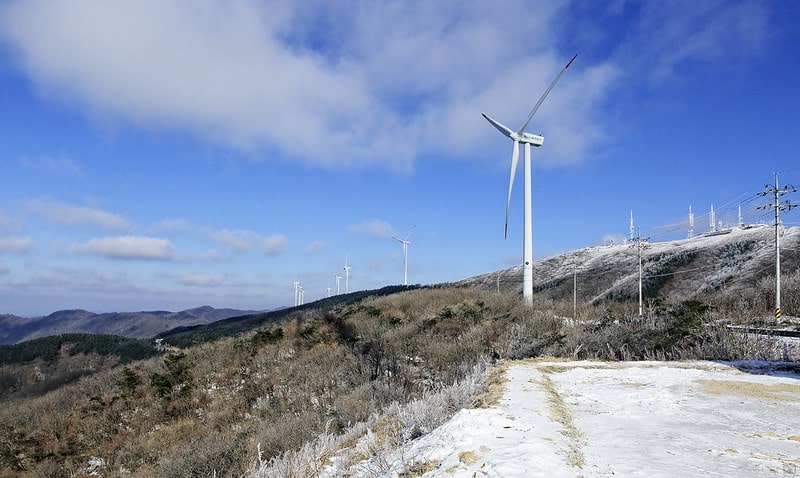In 2020, renewables were the only energy sector that remained relatively unharmed during the pandemic and consequent recessions. Fossil fuels did not enjoy the same fortunes. The demand for oil, coal and natural gas all fell in 2020, trends that are expected to continue for the foreseeable future. Given the already declining costs of renewable energy, a rapid transition scenario towards clean energy over the next few decades is becoming increasingly realistic. While rife with profitable opportunities and promises of better environmental stewardship, the transition towards renewables will inevitably cause a degree of disruption to the global economic and political order, and these geopolitical shifts could shape the transnational relations and superpower statuses of the 21st century.
—
Since humans first began using them, fossil fuels have influenced our geopolitical map. Combustible fuel sources ushered in the modern era of cheap energy and high standards of living, creating international hierarchies and systems of power defined by who is able to extract and sell fossil fuels and who is in need of them.
Since the rise of the petroleum industry in the Middle East in the early 20th century, fossil fuels have played a pivotal role in international politics. Countries with abundant stores have made the extraction, production and export of hydrocarbons their primary source of revenue. Producers have extended their resources to others as a tool for international diplomacy and soft power expansion. Competition and scarcity have placed the resource at the centre of strategic economic planning and trade accords for wealthy and poor nations alike.
Fossil fuels, especially oil, have influenced the wars we have fought over the past century. The notion of petro-aggression has become a topic of extensive research and debate, with some scholars finding that countries whose revenue from oil exports exceeds 10% of GDP are twice as likely to engage in inter-state conflict than other nations.
International market booms and busts have been defined by oil prices and the actions of the world’s major fossil fuel producers. The oil supply crises of 1973 and 1979 demonstrated just how dependent our markets were on the stable production and supply of oil. Any sudden rise in prices or a drop in production in exporter countries could cause shortages and market failures on the other side of the world.
The period of fossil fuels being a driver or at least an influencer of international relations and geopolitics may soon be coming to an end. In the late 20th and early 21st century, observers were concerned about the scarcity of fossil fuels, and that we would deplete our supply before being able to transition to alternative sources of energy. Now, this transition may begin before fossil fuel scarcity becomes a reality, due to renewables’ declining costs, technological innovations and growing investor interest.
When this shift happens, the world will look very different. Cleaner, for sure, but also with redrawn battle lines and new energy superpowers. Gone will be the undentable influence of fossil fuel producers and supermajors. They will be replaced by those who started their transition early, invested heavily in research and development and built up their capacity for clean energy. The nature of renewable power might make this new order less unstable and conflict-ready, and perhaps even somewhat utopian, although many risk being left behind during the transition. Regardless, the political developments and government action taken during this decade will define what the future of our energy grid and geopolitical positioning will look like.
Leaving Carbon Behind
While energy demand is set to increase over the coming years due to population growth and higher incomes, the absolute demand for fossil fuels is expected to fall. Spencer Dale, chief economist for BP, recently told reporters, “Never in modern history has the demand for any traded fuel declined in absolute terms” and “the share of renewable energy grows more quickly than any fuel ever seen in history.”
Just a few years ago, it would have been unthinkable for a high-ranking executive of a major oil corporation to say this. But the energy transition is real, and the share of fossil fuels in our global energy mix is expected to fall from 85% in 2018 to between 20 and 65% by 2050, depending on how fast countries move away from fossil fuels. Meanwhile, the global share of renewables is set to grow from 5% in 2018 to as much as 60% by mid-century.
You might also like: Why Solar Power is So Important for India
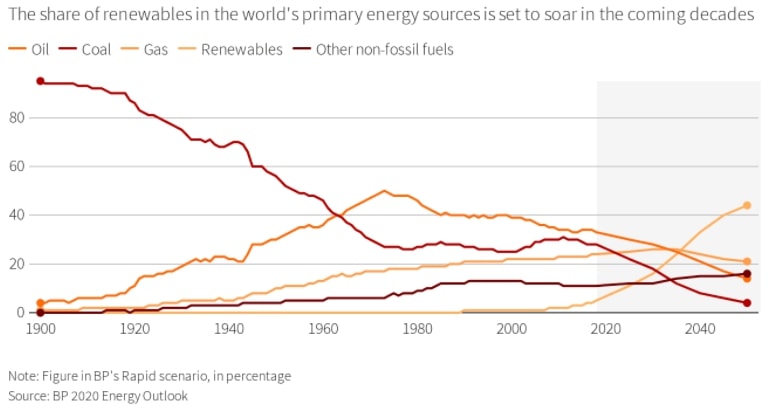
Figure 1: Historical and projected shifts in global energy mix; Reuters; 2020.
Decarbonisation has largely been driven by new technologies and innovations that have improved the efficiency of our energy grid and pushed down costs. Developments in battery storage, smart grids with Internet of Things technology and artificial intelligence have made sectors such as solar and wind more reliable and safer to invest in. The transportation, construction and industry sectors, once dominated by fossil fuels, have also been transformed by electric vehicles and green building materials.
The countries that have taken the decisive step to leave carbon behind in their policy planning and focus their resources on developing and implementing these new technologies have positioned themselves at the forefront of the race for global leadership in the age of low-carbon energy. In this global repositioning of states, countries whose economies are reliant on exporting fossil fuels will be hit the hardest, while countries who have historically relied on fossil fuel imports need to actively invest in developing their renewable energy sector.
A Global Repositioning
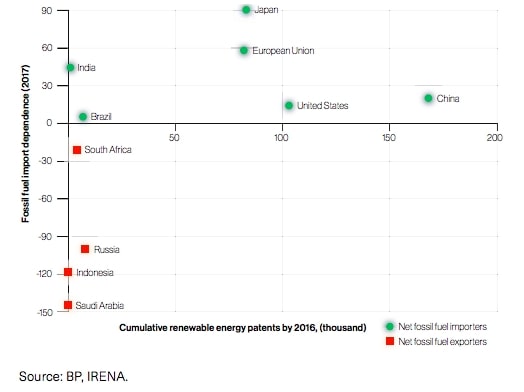
Figure 2: Impact of energy transition on selected countries and the EU; International Renewable Energy Agency; 2019.
The graph above shows the reliance of some countries on fossil fuels, as well as how prepared they are for the energy transition. The y-axis indicates how much of a country’s proportion of total energy consumption is made up of fossil fuel imports. The x-axis represents how far along each country is in developing their renewable energy infrastructure. Countries whose economies are dependent on exporting fossil fuels, such as Saudi Arabia and Russia, will encounter severe challenges as demand for their primary exports continues to decrease. Countries with a falling reliance on foreign imports and who are starting to wean themselves off fossil fuels by actively investing in renewable energy technology, such as China, will fare far better.
China is already the world’s largest investor in renewable energy, and there is a growing consensus that it will maintain its status as a global energy leader during the energy transition. For years, China has been investing heavily in renewable technologies, and is expected to experience significant and sustained growth in this regard. The International Energy Agency estimates that 36% and 40% of respective expansion in the global solar and wind energy market over the next five years will be in China. Of all global investments toward electric vehicles over the next five to ten years, it is expected that nearly half will occur in China. At the moment, the country remains somewhat dependent on imported oil, but appears to be doing everything in its power to develop the technologies it will need to reduce its reliance on foreign actors.
Much like fossil fuels have been used as tools of diplomacy, China is improving its global soft power standing by financing renewable energy projects abroad: a super-efficient power station in Kenya, South America’s largest solar farm in Argentina and Scotland’s largest offshore wind farm are just a few examples of how China has been aggressively bankrolling cutting-edge green technology and renewable energy infrastructure across the globe over the past 10 years. As other major powers such as the US, the EU and Japan lag behind in terms of renewable energy investments, China is positioning itself at the forefront of the green financing market. More recently, China has also been working towards integrating its green finance ambitions into its Belt and Road Initiative. The soft power China could accrue through its green foreign investments would considerably increase Beijing’s political, financial and commercial clout abroad in the years to come.
China’s dominance in the global renewable energy market has encountered international resistance in the shape of sanctions and tariffs aimed at reducing imports from China. The US has imposed and expanded tariffs on Chinese solar producers as part of the larger trade war between the two countries, and most recently began restricting trade activity pertaining to wind energy. The EU ended its trade sanctions on Chinese-produce photovoltaic panels in 2018, but fresh concerns abound given the increased international scrutiny towards labour conditions in the country’s western provinces, where many solar panels and wind turbines meant for export are manufactured.
The US, despite a lack of investment in active decarbonisation, can be considered to be in a relatively strong position in the clean energy transition. The US is largely self-sufficient in its energy consumption, being able to export more energy than it imported in 2019. The country still lags behind China in many fields, however, particularly considering China’s growing soft power reach.
Wealthy economies such as the US, the EU and Japan also hold an advantage because of their capacity for technological innovation and R&D, especially in fields such as robotics and AI. These countries are currently leading innovation in these fields, although China is fast catching up. Countries with abundant capital and high-quality research institutions are able to position themselves at the forefront of investments towards developing new renewable energy technologies, which will be critical to informing any geopolitical shifts. The renewable energy market is one with a high ceiling for innovation, and in lieu of widespread political and economic transformation, technological advancement is critical to lowering costs and implementing a renewable energy grid.
Technological innovations are making energy grids more intelligent, efficient and digitalised, but modern technologies and new entry points to the grid may potentially open the door to a different kind of energy warfare in the shape of cyberattacks. In 2015, a power grid in Ukraine was hacked and infected with malware that took 30 substations offline, placing hundreds of thousands of people in blackout conditions for hours. Cybercrime is an issue that predates the energy transformation, however, and expertise from industries which have always had cybersecurity concerns, such as banks and financial companies, can inform new Internet-based energy grids on how to defend themselves against virtual intrusions.

Figure 3: Global distribution of top markets for potential solar and wind power capacity; Deloitte Insight; 2018.
The graph above shows the countries with the highest potential for solar and wind power generation. If sufficient investments are made, countries rich in renewable capacity such as Chile and Australia could become leading net exporters of renewable energy. Other countries rich in the rare Earth minerals necessary for renewable energy technologies, such as Bolivia and the Democratic Republic of the Congo, could in theory place themselves at the centre of reshaped global supply chains, potentially boosting their economies if the right policies and systems of governance are put in place.
For countries currently reliant on fossil fuel exports, the picture is increasingly bleak. These countries will need to completely reinvent their economies to compete, but so far many have displayed an aggressive staticity in doing so. In countries with weak governance and homogenous economies reliant on their exports, a continuous decline in international demand for fossil fuels could lead to political instability and social fracturing.

Figure 3: Relative preparedness of fossil fuel producers for energy transition. Y-axis indicates the level to which an economy is reliant on fossil fuel exports. X-axis indicates the extent to which a country’s income levels could manage an energy transition; International Renewable Energy Agency; 2019.
The graph above shows the countries most at risk of encountering severe economic and political challenges in the event of an energy transition. If these countries do not internally diversify their economies, they will suffer severe social consequences. In unprepared countries with growing youth populations, such as Nigeria, an energy transition will most likely mean consistently high unemployment rates.
Some wealthy exporter countries, such as the UAE and Qatar, have implemented comprehensive policy plans to diversify their economies and energy sectors. For those countries without such financial capital and at risk of being left behind in the energy transition, investments and support from emerging energy superpowers such as China can bridge the gap towards setting up the right infrastructure, but they need to happen now if they are to have any effect.
The Dream of Self-Sufficiency
Perhaps the most important difference between a fossil fuel-heavy energy grid and one dominated by renewables and low-carbon alternatives is the potential for self-sufficiency that the latter implies.
In a 2019 report, the International Renewable Energy Agency examined the geopolitics of energy transformation, and what it will mean for developed and developing countries alike. In an energy system based on renewables, countries will be able to develop their own capacity for power generation and reduce reliance on foreign imports. For example, a major part of China’s motivations to pursue clean energy alternatives is to alleviate its reliance on fossil fuel imports. By 2017, China’s investments towards clean energy had reduced its fossil fuels import gap by around 20%.
Energy self-sufficiency is something all countries desire, rich and poor. Fossil fuels never really allowed for self-sufficiency because there are only a few geographic areas where they can be extracted, but renewables can be sourced in some form virtually anywhere.
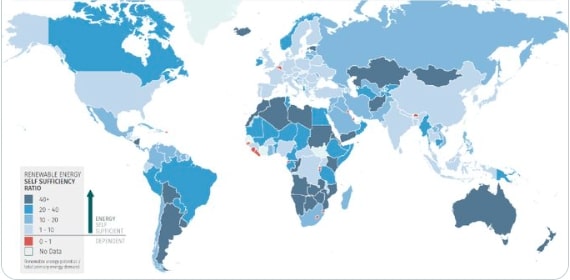
Figure 4: Renewable energy self-sufficiency potential. Based on a report by the UN Development Programme and the international non-profit Climate Analytics, virtually all countries have renewable energy potential 20-80 times greater than current energy consumption levels require; Climate Analytics; 2016.
Even in the case of China, which is financing and issuing loans across the planet supporting renewable energy projects, foreign aid is not expected to remain a constant burden for its recipients. Fossil fuel exporters were only able to wield such extraordinary geopolitical influence for such an extended period of time because other countries could not source enough oil or gas in their own territories. In the case of renewables, foreign actors are only involved until a country’s renewable energy infrastructure is set up, expertise shared and technology developed. Once that is done, the targeted country becomes virtually self-sufficient in its energy production.
Certain actors will certainly have more power, capital and influence than others and will be expected to exert their strengths. Some degree of global energy trade and import-export will also continue to exist. But nowhere in the world will countries become wholly dependent on a single foreign provider for their energy needs as is the case with fossil fuels. On the topic of China’s influence, Olafur Ragnar Grimsson, the former president of Iceland and chair of the Global Commission on the Geopolitics of Energy Transformation has said “China can help countries on the road to renewable energy. But once they are there, they can no longer exert power, as the oil-rich countries have done over the years.”
The global renewable energy trade market won’t be nearly as antagonistic or competitive as the fossil fuel market has been, as the abundance and diversification of renewable energy resources promises to engage countries in much more cooperative relationships. A current indicator of what future renewable energy trade relations could be is the North Sea Link, a submarine electricity cable connecting England to Norway planned to be completed later this year. The cable will connect the energy markets of both countries and respond to respective fluctuations in energy demand. The UK is building up its capacity to become largely reliant on wind power over the next five years, which by its very nature is intermittent. During periods of low wind, the link allows England to source energy from Norway’s grid, primarily powered by more consistent hydropower. Similarly, during periods of high winds and low energy demand in the UK, surplus electricity can be easily transferred to Norway’s energy grid.
Being reliant on fossil fuels means being reliant on international supply chains, meaning that the sometimes volatile and unpredictable conditions of global maritime trading routes can affect energy markets worldwide. Around 61% of the world’s petroleum is transported by sea, almost all of which passes through the Straits of Hormuz and Malacca. Blocking just one of these corridors, even temporarily, can catastrophically disrupt international energy markets and cause energy prices to skyrocket. Tankers in these areas have also been historically vulnerable to piracy and theft of cargo. Between 2010 and 2017, over 750 hijacking attempts occurred in the Strait of Hormuz, which have particularly affected the exports and economies of smaller oil producers such as Bahrain and Kuwait. Meanwhile, the Gulf of Guinea in Western Africa – where in 2020 at least 132 attacks and 95% of kidnappings from vessels occurred – has become a hotbed for maritime piracy and hijacking activities over the past five years.
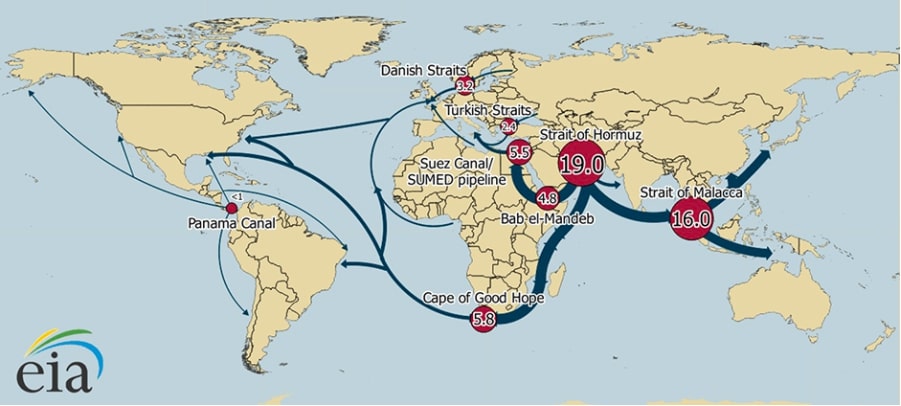
Figure 2: Transport volume of barrels of petroleum per day (in millions) through maritime trading chokepoints; US Energy Information Administration; 2017.
International fossil fuel supply chains are highly centralised, in that their stability is dependent on circumstances in exporter countries. When extraction and production decline, as normally happens during times of war, or when exporters raise prices unilaterally through embargoes, they can induce economic crises across the globe. A system that is able to successfully transition to renewables offers the benefit of being largely decentralised and diversified.
While individual actors and major states may rise or fall, the promise of self-sufficiency of renewable energy is guaranteed to be equally if not more decisive in defining the new geopolitical order. The possibility for smaller nations to take advantage of their own resources and reduce dependence on foreign imports, influences and agendas will significantly alter the geopolitical map of the 21st century and beyond. Spheres of power from major states will presumably shrink substantially, and smaller nations will have increased agency and productivity.
If the rate of technological innovation continues at its current rate, it is not inconceivable that transitioning to renewables will edge us closer to a post-scarcity economy, where resources are abundant and goods such as energy can be disbursed equitably. While post-scarcity is probably still quite a ways away, moving away from fossil fuels, decentralising our energy system and permitting countries to become self-sufficient may lessen our propensity for conflict and military confrontation over scarce and limited resources. Transitioning to a system of plentiful renewable energy may bring us closer to realising the value of energy as a basic human right, rather than an obstacle to be purchased or fought over.
Featured image by: Flickr








